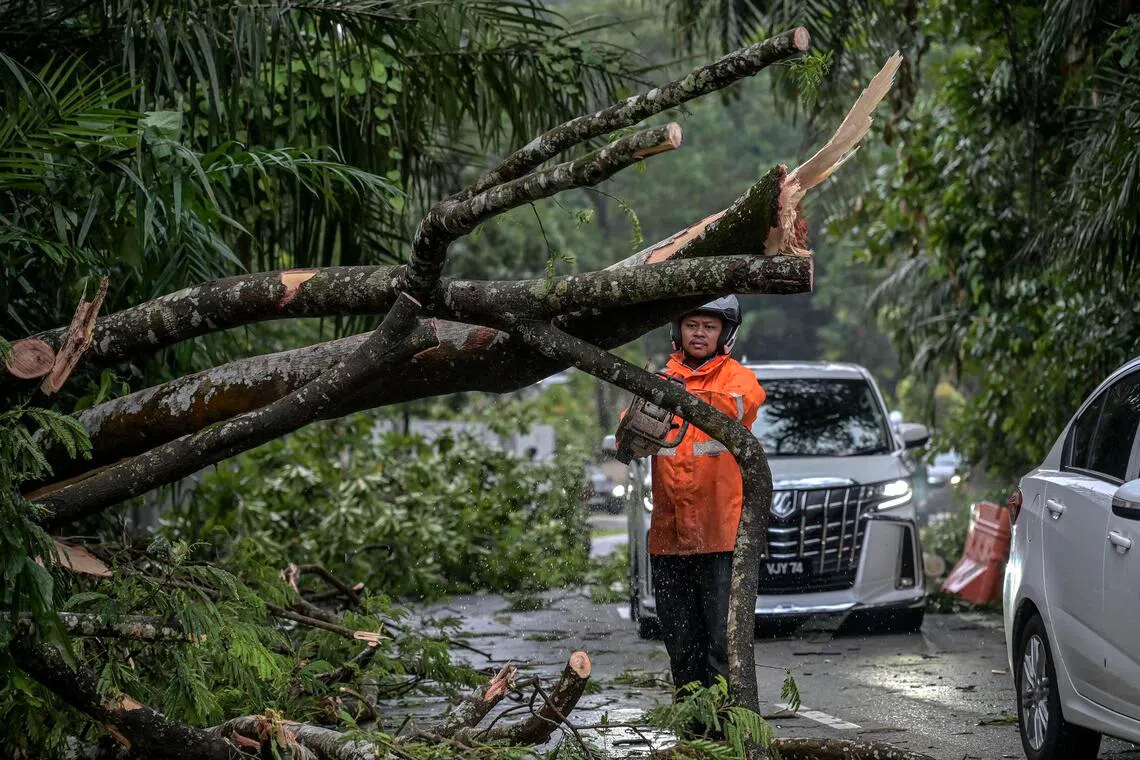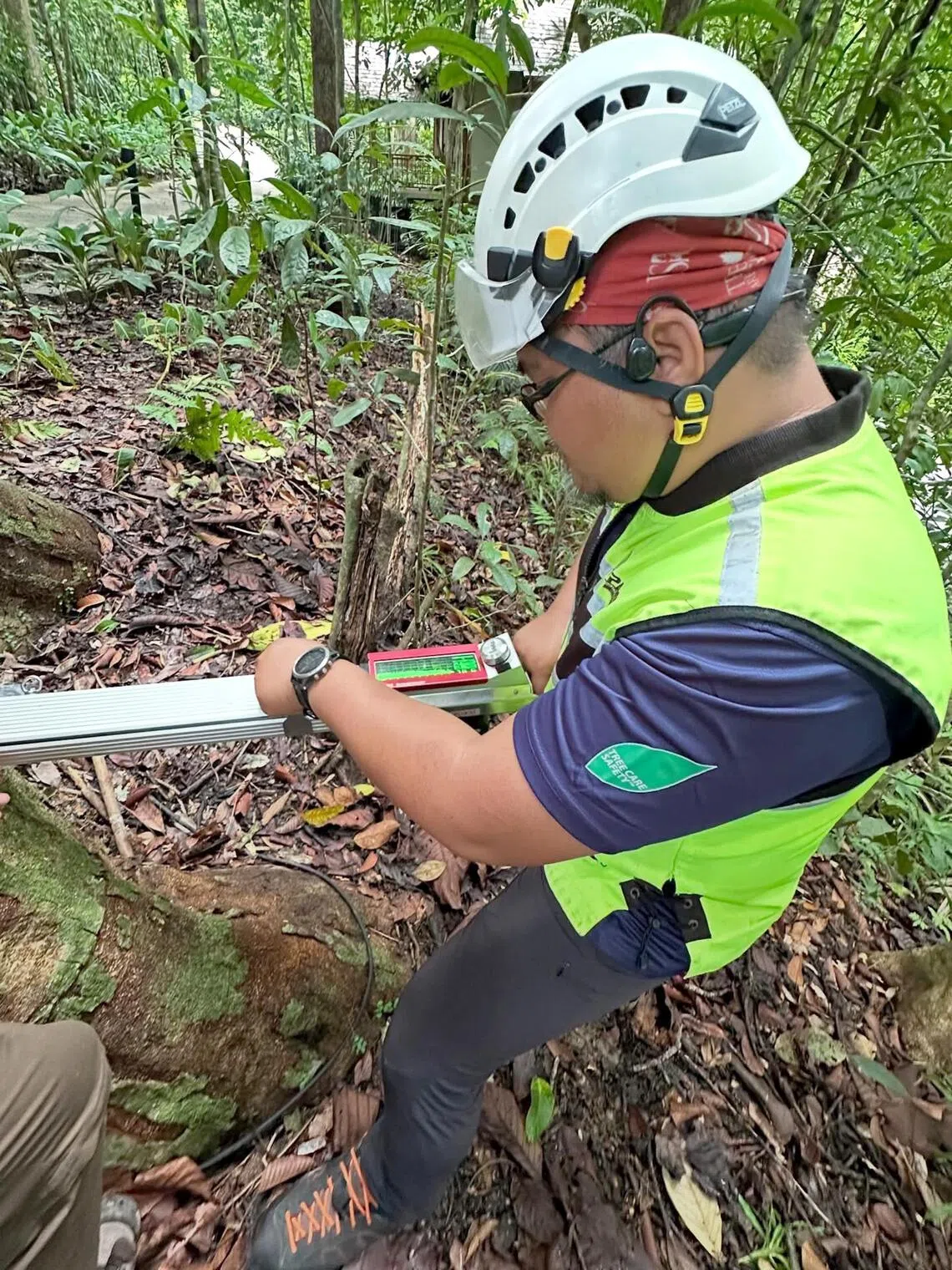Ageing canopy turns fatal hazard as Malaysia faces rising tree-fall incidents
Sign up now: Get insights on the biggest stories in Malaysia

In separate incidents on Oct 22, a man was killed and a woman was injured when trees fell onto their cars during a heavy downpour in the city.
PHOTO: BERNAMA
Follow topic:
- Housing and Local Government Minister Nga Kor Ming pledged vigilance after fallen trees killed at least three since September 2025.
- Kuala Lumpur City Hall plans to increase tree maintenance spending from RM27 million annually. They will use digital databases and boost response teams to strengthen urban resilience.
- Urban expansion and extreme weather weaken trees. Experts urge for more frequent checks and arborists.
AI generated
KUALA LUMPUR – Malaysia’s Housing and Local Government Minister Nga Kor Ming on Oct 29 pledged extra vigilance from the authorities, after a spate of fallen trees nationwide which has killed at least three people since September 2025.
In two separate incidents on Oct 22, a man was killed and a woman was injured when trees fell onto their cars during a heavy downpour in Kuala Lumpur, which saw several trees uprooted across the capital.
Similar tragedies have happened regularly in the last few years, highlighting how the country’s ageing green canopy, its source of shade and pride, has become a public safety concern, prompting the authorities to take action.
“We will continue to monitor (the situation),” Mr Nga told reporters on Oct 29 when asked about the string of incidents. He added that the Kuala Lumpur City Hall (DBKL) already maintains an inventory of trees with a scheduled monitoring system in place.
“We will do whatever is humanly possible. I for one, and Dato Seri Maimunah, believe prevention is always better than cure. There are thousands of trees that grow healthily,” he said, referring to KL Mayor Maimunah Mohd Sharif.
In a written reply to The Straits Times, Madam Maimunah said the “DBKL is committed to ensuring public safety, maintaining a green and liveable city, and strengthening urban resilience to climate change”.
She listed measures such as developing a digital tree database, performing routine pruning and root care in high-risk areas, planting hardy local species, and boosting rapid response mechanisms for tree incidents.
DBKL expects tree maintenance costs to rise from around RM27 million (S$8.3 million) per year currently as it plants new trees and cares for ageing plants. It currently has six arborists and 21 arborist contractors, and also sends staff for arboriculture certification annually.
On May 16, 2024, Minister in the Prime Minister’s Department (Federal Territories), Dr Zaliha Mustafa, announced a task force to monitor and maintain shade trees across KL, after a man died and another was injured
A few days later, on May 13, another tree fell nearby
Following the incidents, Datuk Seri Dr Zaliha also said DBKL would cut down aged and high-risk trees around the city and develop new guidelines related to such trees.
Since then, trees have continued to topple. Photos of crushed cars and blocked roads have become a familiar sight during the monsoon months.
As at Oct 28, 2025, Malaysia’s Fire and Rescue Department had recorded 3,700 fallen-tree cases nationwide, with seven deaths reported so far this year. A total of 15 deaths were recorded in 2024, up from 10 in 2023.
The department logged 5,232 cases in 2024, an 8.4 per cent increase from 2023, before dipping in 2025.
“Although this looks lower compared to last year’s total, the monthly average for 2025 shows that the incidence trend remains high,” its director-general Nor Hisham Mohammad said in a written response to ST.

A fallen tree in Kluang on Jan 12 injured four people.
PHOTO: MALAYSIA FIRE DEPARTMENT/FACEBOOK
Datuk Seri Hisham said fallen trees occur especially during monsoon transition phases, and during storms that often take place in several major states such as Selangor, Kuala Lumpur, Johor, Sabah and Sarawak.
In addition, he urged the public to avoid taking shelter under large trees during thunderstorms to prevent any deaths or injuries.
With the cases climbing over the last few years, several experts told ST that urban expansion has placed increasing strain on KL’s mature trees.
Independent certified arborist Saifful Pathil, who trains tree specialists and conducts risk assessments, said even the best monitoring systems have limits against erratic weather.
“Currently, DBKL is more proactive in dealing with large trees. Tree assessments are conducted using resistograph and picus tomograph machines, which are very good,” he said, referring to tools which indicate a tree’s internal condition. The machines are used to scan inside a tree trunk, checking for rot or cavities without having to cut the tree down.
However, many urban collapses stem from poor planning since some developments and constructions ignore the condition of existing trees, and only consult arborists after their projects are completed.
Construction activities can harden soil and prevent root growth. When this happens, the canopy can become too heavy for weakened roots to support, leading to toppling. Extreme weather has worsened this through the “sailing effect”, where tall trees catch strong winds and become more prone to toppling.

Independent arborist Saifful Pathil assessing the condition of a tree using a resistograph machine.
PHOTO: SAIFFUL PATHIL
Mr Saifful noted that tree assessments occur only once every year or two, and Malaysia has roughly 150 certified arborists, compared with around 600 in Singapore – despite being almost 500 times bigger than its southern neighbour.
“We can minimise risk by checking trees more frequently and having more trained arborists,” he said.
By contrast, Singapore – which also faces similar tropical weather – has rolled out several new technologies to tackle the problem since 2023. The National Parks Board (NParks) is using a new greenery-management model that uses artificial intelligence (AI), Internet of Things sensors, and tree-monitoring dashboards to boost safety in parks and streetscapes.
Since 2018, NParks has installed over 1,500 sensors on trees to monitor their condition and help prevent them from toppling.
Some local councils in Malaysia are also now turning to technology to better manage urban trees. On Oct 4, the Penang Island City Council launched an AI-powered system for tree inventory and inspection, aimed at improving monitoring and early detection of risks.
Dr Shuhana Shamsuddin, president of the Malaysian Urban Design Association, a non-profit organisation that promotes good urban design practices in Malaysia, said trees are often treated as an afterthought.
“People forget that roots spread roughly the same width as the canopy. When roads or buildings are too close, they disrupt the roots, weakening the tree. That’s why branches die prematurely,” she said.
“Our problem is we don’t plan and design the environment as we build more skyscrapers for the city.”
Sign up for our weekly
Asian Insider Malaysia Edition
newsletter to make sense of the big stories in Malaysia.

